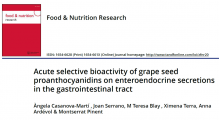MoBioFood recently published a paper in the journal Food and Nutrition Research
Àngela Casanova-Martí et al. investigated in deep the mechanisms used by GSPE to increase GLP-1, and extend it to its role at modulation of other enterohormones.
Abstract
Background: Enteroendocrine cells respond to food components by secreting an array of hormones that regulate several functions. We have previously shown that grape seed proanthocyanidins (GSPE) modulate GLP-1 levels.
Objective: To deepen on the knowledge of the mechanisms used by GSPE to increase GLP-1, and extend it to its role at modulation of other enterohormones.
Design: We used an ex vivo system to test direct modulation of enterohormones; STC-1 cells to test pure phenolic compounds; and rats to test the effects at different gastrointestinal segments.
Results: GSPE compounds act at several locations along the gastrointestinal tract modulating enterohormone secretion depending on the feeding condition. GSPE directly promotes GLP-1 secretion in the ileum, while unabsorbed/metabolized forms do so in the colon. Such stimulation requires the presence of glucose. GSPE enhanced GIP and reduced CCK secretion; gallic acid could be partly responsible for this effect.
Conclusions: The activity of GSPE modulating enterohormone secretion may help to explain its effects on metabolism. GSPE acts through several mechanisms; its compounds and their metabolites are GLP-1 secretagogues in ileum and colon, respectively. In vivo GLP-1 secretion might also be mediated by indirect pathways involving modulation of other enterohormones that in turn regulate GLP-1 release.
GLP-1; Phenolic compounds; colon; enterohormone; ileum

